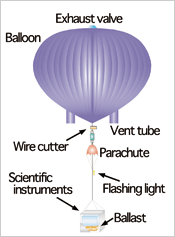


Balloon launch at the Taiki Aerospace Research Field, August 2008
Q. What is the purpose of JAXA's balloon-borne experiments?
Scientific balloons are not the same as hot air balloons, which people are more familiar with. Scientific balloons are unmanned, and inflated with helium gas. Their purpose is to carry a payload of scientific instruments to the stratosphere, three to four times as high as passenger aircraft can fly.
Space science studies the formation and future of our planet and of the universe, looking at the farthest reaches of the cosmos. In this type of research, there are three advantages of observing from space: 1) to avoid atmospheric interference, which prevents us from receiving incoming information from space; 2) to observe unique phenomena on site; and 3) to carry out space-based experiments in the unique environment at very high altitudes, where there is no or next to no air. Although balloons need buoyancy to float, and therefore cannot travel beyond the atmosphere, they have a longer history than satellites and launch vehicles, and still have many advantages today. With these advantages, scientific balloons have continued to make great contributions to space science.Q. What are the advantages of balloons, compared to satellites and launch vehicles?

Schematic of a balloon system
Satellites and launch vehicles must use powerful engine thrust to exit our atmosphere into airless outer space. Balloons, on the other hand, use simple buoyancy principles to float, and can stay near the edge of the atmosphere for long durations. Balloons can take a bigger and heavier payload, and are easier to launch than satellites and launch vehicles. Also, because of the relatively low cost of balloon-borne experiments, we can provide more flight opportunities. Finally, it is a great advantage that the payload can be recovered after the flight.
Because of these advantages, balloons have been used to conduct many advanced scientific studies of rare space phenomena by precise observation, with instruments that are too big for satellites and launch vehicles. For example, in 2006, JAXA collaborated with Brazil to carry out observations with an eight-meter-long X-ray telescope. Also, before I joined JAXA, I collaborated with NASA to launch a payload with more than 2,000 kilograms of scientific equipment, for cosmic ray observations carried out over Canada and Antarctica.
Q. Could you tell us what your laboratory does?

Balloon flight path

Fully inflated balloon at floating altitude

Taiki Aerospace Research Field
We provide opportunities for scientific balloon-borne experiments, and develop next-generation balloons that drive new space science.
In Japan, balloon-borne experiments are carried out twice each year, for two to three weeks starting at the end of May and at the end of August. These are the best times to get a long flight and easy recovery. A balloon released on the coast of the Pacific Ocean ascends with westerly winds. After reaching its float height, it returns to Japan on winds from the east. When a balloon is launched with wind blowing slowly from the United States to Japan at the float height, we can prolong the duration of the experiment. That's why we aim to take advantage of the brief periods when these winds are blowing, launching four or five balloons twice a year, about ten in total.
Every October, we review public applications for balloon-borne experiments. As soon as we pick the experiments for the following year, we begin working with the science groups on preparations. We discuss the balloon payloads and the communication setup between the ground and the balloons. If necessary, we develop a payload together. Based on the required float altitude and the weight of the payload, the appropriate balloon is selected from sizes varying from about ten meters in diameter to the size of the Tokyo Dome stadium. Payload preparation starts at the Sagamihara campus of the Institute of Space and Astronautical Science. This is a vital step to ensure the successful performance of the payload. Once the payload is ready, it is transferred to the Taiki Aerospace Research Field in Hokkaido for assembly and final inspection. Finally, we wait for good conditions: the fine weather on the ground, and good wind speed and direction in the upper sky.